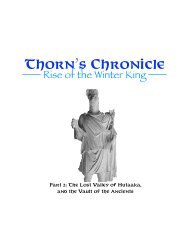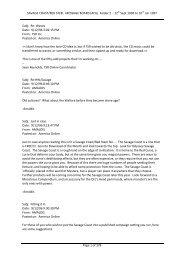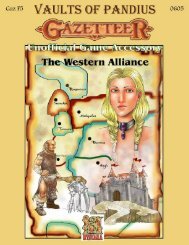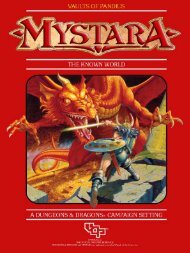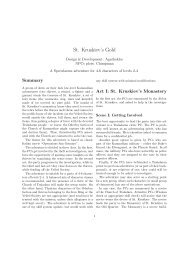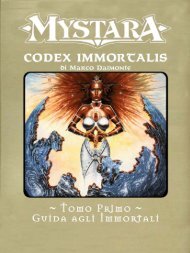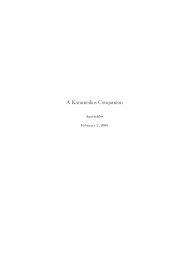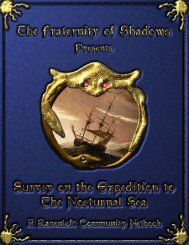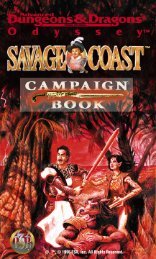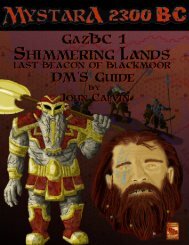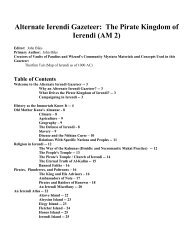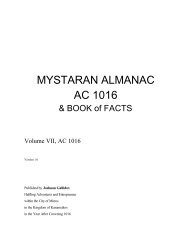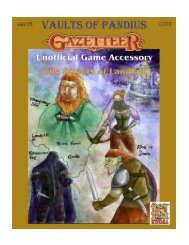The Heldannic Order - Vaults of Pandius
The Heldannic Order - Vaults of Pandius
The Heldannic Order - Vaults of Pandius
Create successful ePaper yourself
Turn your PDF publications into a flip-book with our unique Google optimized e-Paper software.
HISTORY AS THE IMMORTALS KNOW IT<br />
<strong>The</strong> <strong>Heldannic</strong> Territories. <strong>The</strong> Heldann<br />
Freeholds. Nordurland. Vanitaheim.<br />
Numerous names have graced the<br />
coastal land north <strong>of</strong> the Ethengar<br />
Steppes, reflecting the succession <strong>of</strong><br />
powers that the inhabitants have endured.<br />
As the Immortals know, the <strong>Heldannic</strong><br />
Knights are but the most recent invader<br />
since the glacial ice released this ancient<br />
land.<br />
<strong>The</strong> Land <strong>of</strong> Ice and Fire<br />
<strong>The</strong> modern <strong>Heldannic</strong> Territories were<br />
once a region buried beneath hundreds <strong>of</strong><br />
feet, perhaps thousands, <strong>of</strong> ice. Only the<br />
massif known as the Altar <strong>of</strong> Vanya<br />
crested above the blue-white landscape.<br />
Ancient dragons and giants occasioned<br />
the area during the infancy <strong>of</strong> man, but<br />
their presence was never large. When the<br />
forgotten Blackmoor civilization was<br />
nearing its technological zenith, the<br />
region’s dragons disappeared altogether.<br />
This state <strong>of</strong> affairs might have<br />
persisted were it not for the worldshattering<br />
Great Rain <strong>of</strong> Fire.<br />
<strong>The</strong> Rain unleashed a torrent <strong>of</strong><br />
destruction upon Mystara and produced a<br />
realignment <strong>of</strong> the planetary axis. <strong>The</strong><br />
dominant human culture, deprived <strong>of</strong> its<br />
technology, was thrown into a new stone<br />
age. Groups fought one another as they<br />
struggled to re-master ancient techniques<br />
such as working with bronze, hunting,<br />
and agriculture.<br />
Another consequence <strong>of</strong> the Rain was<br />
the migration <strong>of</strong> the glaciers that<br />
composed the polar ice caps. <strong>The</strong> eastern<br />
ice flowed over Heldann enroute to the<br />
Norwold coast.<br />
Different groups <strong>of</strong> dwarves and<br />
humans made appearances in the region,<br />
as did the giantish clans from the south.<br />
<strong>The</strong> most important population was the<br />
Antalians.<br />
<strong>The</strong> Antalians were an ethnic tribe that<br />
first appeared on Norwold’s coast in<br />
2550 BC subsisting on fishing and<br />
reindeer hunting. <strong>The</strong>y were one <strong>of</strong><br />
many groups that belonged to the<br />
Northern Neathar stock <strong>of</strong> man, but their<br />
success with bronze gave them a<br />
technological edge over their<br />
competitors.<br />
For 800 years, the Antalians expanded<br />
their authority. <strong>The</strong>y drove the rival<br />
Valoin people north and their fellow<br />
Neathar south. Other human groups were<br />
similarly displaced. <strong>The</strong> Antalians even<br />
smashed the giant clans in an epic<br />
conflict over Norwold’s coast.<br />
<strong>The</strong> south became increasingly<br />
important in driving the Antalian culture.<br />
As the need for expansion and conflict<br />
dwindled, craftwork, magic, and<br />
agriculture grew. <strong>The</strong> Vanitar tribe was<br />
especially important in this respect. It<br />
was from this group that the Immortals<br />
Frey and Freyja hailed. <strong>The</strong> Vanitar<br />
eventually travelled to modern Wendar,<br />
where they assisted the newly arrived<br />
Genalleth elves in surviving the<br />
hardships <strong>of</strong> the region.<br />
<strong>The</strong> Antalian Collapse<br />
By 1725 BC, the Antalians had<br />
established a culture that stretched from<br />
Heldann to the Great Bay in Norwold.<br />
Though still able-bodied, the lack <strong>of</strong><br />
competition and the s<strong>of</strong>tening Vanitar<br />
cultural legacies left the Antalians<br />
unprepared for what was to come.<br />
From the west came the Great Horde <strong>of</strong><br />
King Loark. Countless legions <strong>of</strong><br />
humanoids poured into Norwold, and in a<br />
few short years, the Horde destroyed the<br />
Antalian culture. Vanitaheim was the<br />
last Antalian outpost to fall.<br />
Though the damage to the Antalian<br />
culture would last for centuries, Loark’s<br />
occupation was short-lived. Betrayed at<br />
Chongor upon the Ethengarian Steppes,<br />
his forces retreated into the Broken Lands<br />
or scattered elsewhere.<br />
This reprieve disappeared in an instant<br />
as additional calamites fell upon the<br />
Antalians. <strong>The</strong> Glantrian Cataclysm sent<br />
poisonous clouds over western and<br />
central Heldann. Just as the people were<br />
recovering from that even, successive<br />
waves <strong>of</strong> hill gnolls, trolls, and giants<br />
migrated southward through the land.<br />
Human survivors were left in isolated<br />
family groups.<br />
This pattern <strong>of</strong> events came to<br />
characterize the region. Each time the<br />
people were poised for a recovery, giants,<br />
or Ethengarian raiders, or warring elves<br />
interrupted. <strong>The</strong> old Antalian nation had<br />
dissolved into a patchwork <strong>of</strong><br />
independent tribes and villages <strong>of</strong>ten with<br />
3<br />
little communication between them.<br />
Occasional leaders would succeed in<br />
unifying a few neighboring communities<br />
but the harsh landscape and the resistance<br />
<strong>of</strong> the tribes to authority doomed all <strong>of</strong><br />
these efforts.<br />
Over the centuries, the land acquired a<br />
new name – Nordurland.<br />
<strong>The</strong> Nithian Era and its<br />
Aftermath<br />
Far to the south <strong>of</strong> Nordurland, the<br />
Nithian Empire was reaching its zenith<br />
both culturally and militarily. Priests and<br />
magi explored much <strong>of</strong> the Known World<br />
including the humanoid capital Oenkmar<br />
and the western Ethengar Steppes.<br />
It was only a matter <strong>of</strong> time before the<br />
Nithians captured the Northern Reaches<br />
and Nordurland. Local tribes fled as best<br />
they could (e.g. the Renatic people <strong>of</strong><br />
Wendar). Others, such as the Hattic<br />
clans, were enslaved and transported to<br />
outposts on the Isle <strong>of</strong> Dawn or Davania.<br />
Those who remained in western<br />
Nordurland soon found themselves<br />
fending <strong>of</strong>f annual attacks by humanoids<br />
or the wizard Khazad, while those along<br />
the mountains had to contend with gnolls.<br />
Coastal dwellers survived this period<br />
relatively well, until the Immortals<br />
destroyed the Nithian culture in 500 BC.<br />
Without the protection <strong>of</strong> their Nithian<br />
overlords, the coastal residents were<br />
again terrorized by giantish clans, pirates,<br />
and trolls.<br />
Hattian Pride<br />
Meanwhile, the slaves that had been<br />
transported to Davania quickly revolted<br />
and made their new home alongside the<br />
native Hinterland tribes. In 600 BC, the<br />
Davanian tribes were threatened by a new<br />
expanding empire, the Milenians.<br />
Under mounting pressure, three <strong>of</strong> the<br />
former slave tribes took to the sea. <strong>The</strong><br />
escape was secured by the delaying<br />
actions <strong>of</strong> a Kerendan warrior-princess<br />
named Vanya.<br />
<strong>The</strong> Thyatian, Kerendan, and Hattian<br />
people ultimately landed on the eastern<br />
coast <strong>of</strong> modern Thyatis, where they<br />
defeated and absorbed the local<br />
populations. <strong>The</strong> horse-riding Kerendans<br />
claimed the western lowlands, the



